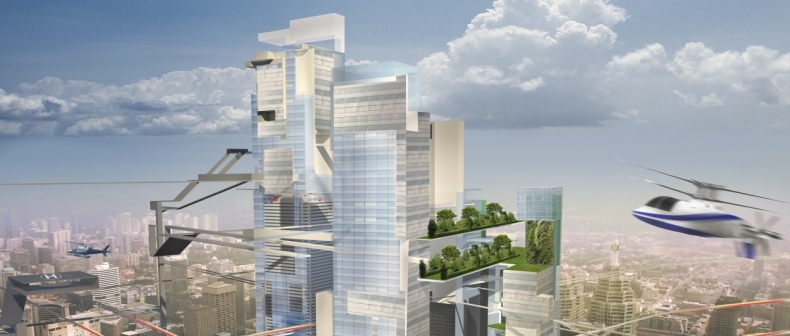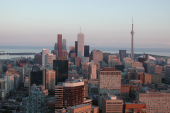
Future of Toronto’s financial district by Onespace Unlimited Inc. Courtesy of Ontario Association of Architects.
Charting a course to 2050 is going to be a daunting task for any city. Over the next few weeks, Justin Robertson will be placing a microscope on Toronto’s key industries and institutions that will be shaped by the predicted population growth facing the city in a series called “The Future of Our City”. The five-part series will examine how the city will be impacted by the aging population, the future of cars and transit and solutions to traffic congestion, and how the face of education and learning environments will change.
This week: We look at the vision of a futuristic Toronto, how our built landscape and infrastructure will evolve and why we are talking about the future of this city right now.
****
By the year 2050 Toronto living will be small. People will live in smaller spaces; perhaps even work from home. Car parking spots will be smaller. Backyards will be tiny or non-existent. The idea of a “community” will change. In the future, a community may consist of a mid-rise apartment building, strapped with amenities. Underground you’ll have access to transit. If grocery stores aren’t located and attached to your lobby, rest assured it’ll be easily accessible by foot. Better still: order your veggies online and have them deliver it to you, much like a hotel. It’s nothing new to learn that Toronto’s population is growing. And fast. It’s how the city of architects, urban planners and government copes with a demanding population that will shape our bustling city. According to The Sydney Morning Herald, population experts estimate that by 2050 more than 60 per cent of the developed world will live in high-density areas, which will see the emergence of “mega cities” — a city that consists of more than 10 million people.
The City of Toronto predicts we’ll hit the three million people by 2020 and the GTA would be looking at six million. It’s clear why condos are going up faster than anyone can imagine, but, even with the future of a concrete jungle before us, it’s still not meeting the population demands — more amenities, a slick and world-class transit system, a walkable city. The latest Census Bureau report titled “Patterns of Metropolitan and Micropolitan Population Change,” revealed cities with a population of more than five million, saw a growth rate of more than 13 per cent in areas close to city hall. Here’s the report. Cities and their infrastructure will be tested in the future if populations keep expanding at the rates they are, especially downtown.
Toronto is knee-deep in “super projects” and hell-bent on adding density. By 2020, this is what Toronto’s skyline will look like. The latest projected condo-development predictions make Toronto look like a “mega-city” – a mega Lego city, that is. Toronto has the highest number of developments under construction in North America. And it doesn’t seem to be slowing. Consider these numbers: Toronto (148), Mexico City (88), New York (86) and Chicago (17). If you break down the people-to-building ratio, it reads something like this: 1439:1 (figure sourced by Dumitru Onceanu, from Urban Toronto.ca). Compare that to New York (1317:1) and it stresses how urbanized Toronto is today and how we need to tread carefully through calculated city planning in order to achieve success in the future.
Reclaiming unused space by RAW Design Inc. Courtesy of Ontario Association of Architects.
City of Toronto chief planner, Jennifer Keesmaat said Toronto has reached a fork in the road and is facing a critical period ahead in urban planning. The Founding partner of Office for Urbanism envisions handfuls of key players shaping Toronto’s future — and that’s a good thing. “The city will be shaped by different players coming together to complete a common vision” she said. “We need to have more conversations about this moving forward. We need to look at best practices elsewhere. We need to take risks and push to take risks — It’s a risk not to take them.”
During Nuit Blanche, Keesmaat was walking along a car-less King Street. Hoards and masses of people were swarming everywhere. It sent a shiver down her spine: “Is this the city of the future? A pedestrian-lived city?” she said. “What we are seeing now is high density in the downtown core and it’s choice people are making. High-density areas should have the best schools, best amenities and the best transit.” One of the city’s planning vision is to build complete communities i.e. neighbourhoods that ooze walkability, connect people to other parts of the city seamlessly and spread density. One current example is the Eglinton Cross Town Study. “Toronto, now, is fundamentally a different place,” she said. “There are some areas of the city that are not complete, people are stranded and don’t have the option to walk to anywhere.”
Roland Rom Colthoff, director of RAW (named Best Emerging practice by OAA in 2009) also member of Toronto’s Urban Design Review Panel said in terms of growth, Toronto is becoming “Manhattanized” with more amenities, developments and people. He paints a future of the city with changes in transit modes. We’ll do away with the car. There will be more biking and walking. More pedestrians. There’ll be an influx of people walking their dogs in the downtown core. Designs that enhance life for pedestrians on the street will become pivotal. Colthoff’s predicts mid-rises are the way forward and the new norm when talking about growing urban communities.
“We can’t have crappy sidewalks. The city will need more parks especially with more people moving downtown. Small spaces will become very important,” he said. “What’s the point of having these lovely looking buildings if the ground below it is broken up and needs construction? Mid-rises are a gentle way to build infrastructure across the city.”
Space is at play here. What we think of a community neighborhood now, will change in 30 years and beyond. Experts predict a farewell to the Victorian-styled houses, armed with a single family near main streets and amenities. What they are saying is we need to utilize space more. Have more families living in low-rise building and build amenities around it — transit too. According to Colthoff, it’s already happening now around the city — in the Beaches, St. Clair West and Queen St. West.
Rahul Bhardwaj, President & CEO of the Toronto Community Foundation, was part of the recent Toronto Vital Signs Report. In his vision of the city, demographics will play a huge part in how the city is shaped.
“In the future, I predict a lot of change especially with urbanization increasing. Change is the new norm,” he said. “Cities are getting bigger, faster than we can catch up. Urbanization needs to have a close relationship with infrastructure. Right now we have a declining birth rate. We are getting older faster.”
The future of architecture is the layering on infrastructure on each other by Steve Culver and Ben Feldman, Intern Architects. Courtesy of Ontario Association of Architects.
For Bhardwaj the “vision of Toronto” discussion is dissected in into the good and the bad (“concerns” or things that could be bad if not addressed). The bad: By 2031, the city will have twice as many seniors as youths; 78 per cent of the city will be immigrants or children of immigrants; 20 per cent of the country will live in Toronto; and by 2025, 60 per cent of Torontonians will live off a low or very low income. The good: Toronto ranks 4th in the latest livable city survey; ranked 12th in the world for start-ups; and placed 3rd in prosperity.
“Look, we are doing some things well and municipal government has more impact now,” he said. “If we don’t work with the right government on things like transit, the city won’t turn out how we want it to be.”
One measure of a successful vision, or rather how to gauge success, according to Bhardwaj, would be to introduce the Happiness Report in policy development. “We need to demand vision from political leaders. We need politicians talking about their vision,” he said. “Think of the change we’ve had in the past 25 years? The next 25 will bring more change. It’s how we going adapt to this change that will determine if we can achieve success.”
According to the city planning department, there is going to ample room to have your say as citizens of this city within public forums and urge a change or vote on a particular urban direction that we should be drifting toward. I say: get involved in those discussions. We’ve got to figure out how to cram a lot more of us into the same amount of space and how to connect our sprawling communities with each other. We all have to live in this city, lets make it an exceptional one. We have the framework; just need the planning and voices.
Next week – Part II: The future of cars and transit: solutions to traffic congestion.
*Note: Images taken from “Future of Architecture” video installation produced by The Ontario Association of Architects (OAA) that presented members’ creativity, predictions and optimism for the future. Recently displayed at the Design Exchange during Nuit Blanche, the exhibit was created by the OAA to provide insight about the possibilities for architecture and to engage the public in a discussion about our collective potential for the cities, societies and countries we live in.
____
Justin Robertson is a freelance journalist from Toronto. His work has appeared in The Walrus, National Post and Toronto Standard. Follow Justin on Twitter @justinjourno
For more, follow us on Twitter @TorontoStandard and subscribe to our newsletter.














